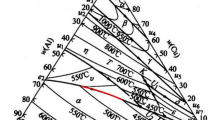Abstract
The study is concerned with develo** low-melting-point filler metals for brazing aluminum alloys. For this purpose, thermal analyses of a series of Al-Si-Cu-Sn filler metals have been conducted and corresponding microstructures observed. The results showed that the liquidus temperature of Al-Si-Cu filler metals dropped from 593 °C to 534 °C, when the amount of copper was increased from 0 to 30 pct. As the copper content reached further to 40 pct, the liquidus temperature would rise to 572 °C. By adding 2 pct tin into the Al-Si-20Cu alloys, the liquidus and solidus temperature would fall from 543 °C to 526 °C and from 524 °C to 504 °C, respectively. The main microstructures of Al-Si-Cu alloys consist of the α-Al solid solution, silicon particles, the CuAl2 (ϑ) intermetallic, and the eutectic structures of Al-Si, Al-Cu, and Al-Si-Cu. For further improvement of the brazability of this filler metal, magnesium was added as a wetting agent, which would remove the residual oxygen and moisture from the brazed aluminum surface and reduce the oxide film. Based on results gleaned from the thermal analyses, a new filler metal with the composition Al-7Si-20Cu-2Sn-1Mg is proposed, which possesses a melting temperature range of 501 °C to 522 °C and a microstructure that includes an Al-Si solid solution, silicon particles, a tin-rich phase, and CuAl2, CuMgAl2, and Mg2Si intermetallic compounds. When this filler metal was used to braze the 6061-T6 aluminum alloy, an optimized bonding strength of 196 ± 19 MPa was achieved.
Similar content being viewed by others
References
Y. Sugiyama: Weld. Int., 1989, No. 8, pp. 700–10.
H. Kawase, T. Takemoto, M. Asano, I. Kawakatsu, and K. Liu: Weld. J., 1989, vol. 68, pp. 396s-403s.
T. Hattori, S. Sakai, A, Sakamoto, and C. Fujiwara: Weld. J., 1994, vol. 73, pp. 233s-240s.
G. Humpston, S.P.S. Sangha, and D.M. Jacobson: Mater. Sci. Technol., 1995, vol. 11, pp. 1161–67.
D.M. Jacobson, G. Humpston, and S.P.S. Sangha: Weld. J., 1996, vol. 75, pp. 243s-250s.
K. Suzuki, M. Kagayama, and Y. Takeuchi: J. Jpn. Inst. Light Met., 1993, vol. 43 (10), pp. 533–38.
T. Kayamoto, J.H. Kim, S. Saito, and T. Onzawa: Proc. Workshop. J. Weld. Soc., 1994, vol. 12, pp. 495–501.
L.F. Mondolfo: Aluminum Alloys—Structure and Properties, Butterworth and Co., London, 1976, pp. 513–15.
T. Osawa: Weld. J., 1995, vol. 74, pp. 206s-212s.
Author information
Authors and Affiliations
Rights and permissions
About this article
Cite this article
Chuang, T.H., Tsao, L.C., Tsai, T.C. et al. Development of a low-melting-point filler metal for brazing aluminum alloys. Metall Mater Trans A 31, 2239–2245 (2000). https://doi.org/10.1007/s11661-000-0141-z
Received:
Issue Date:
DOI: https://doi.org/10.1007/s11661-000-0141-z




